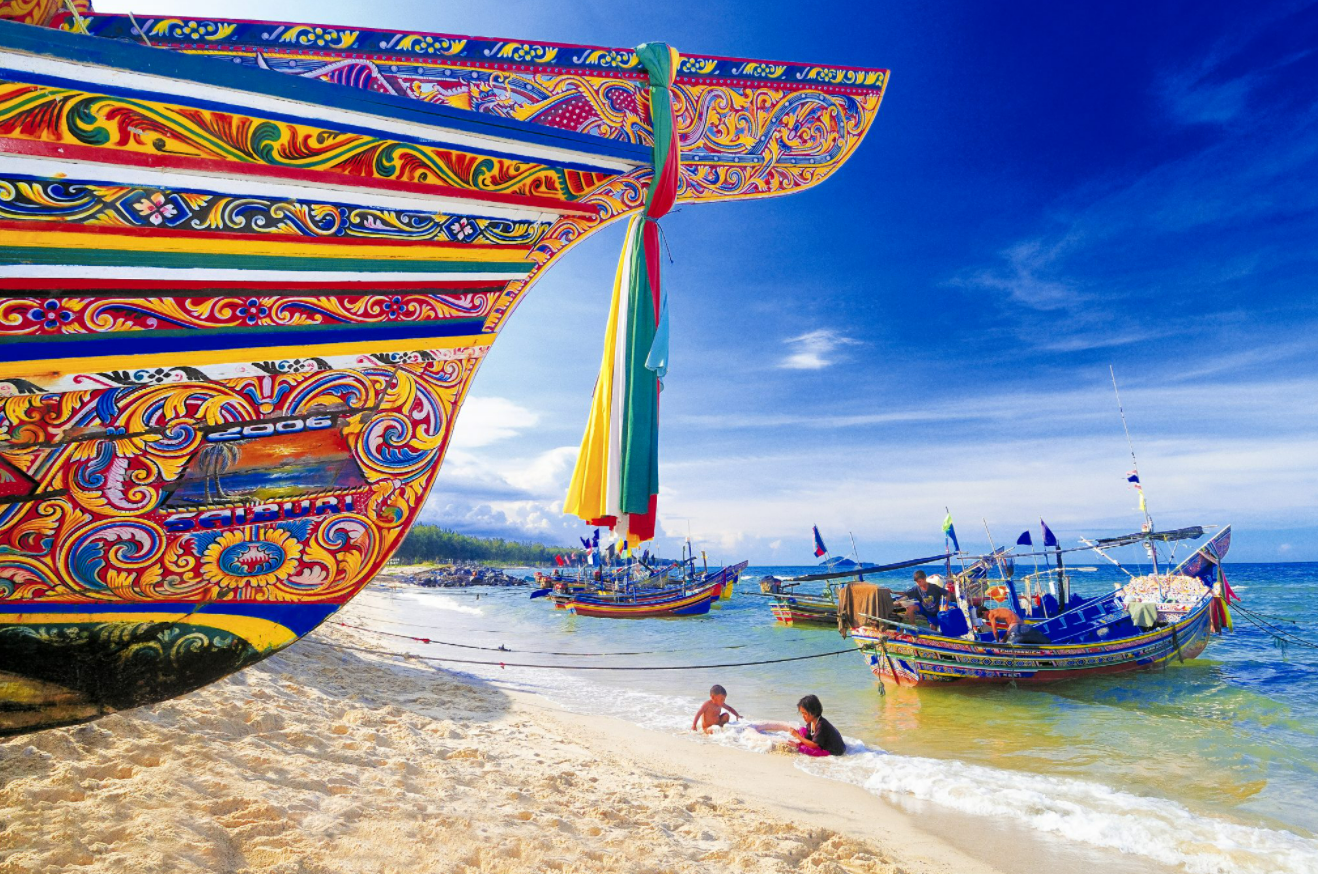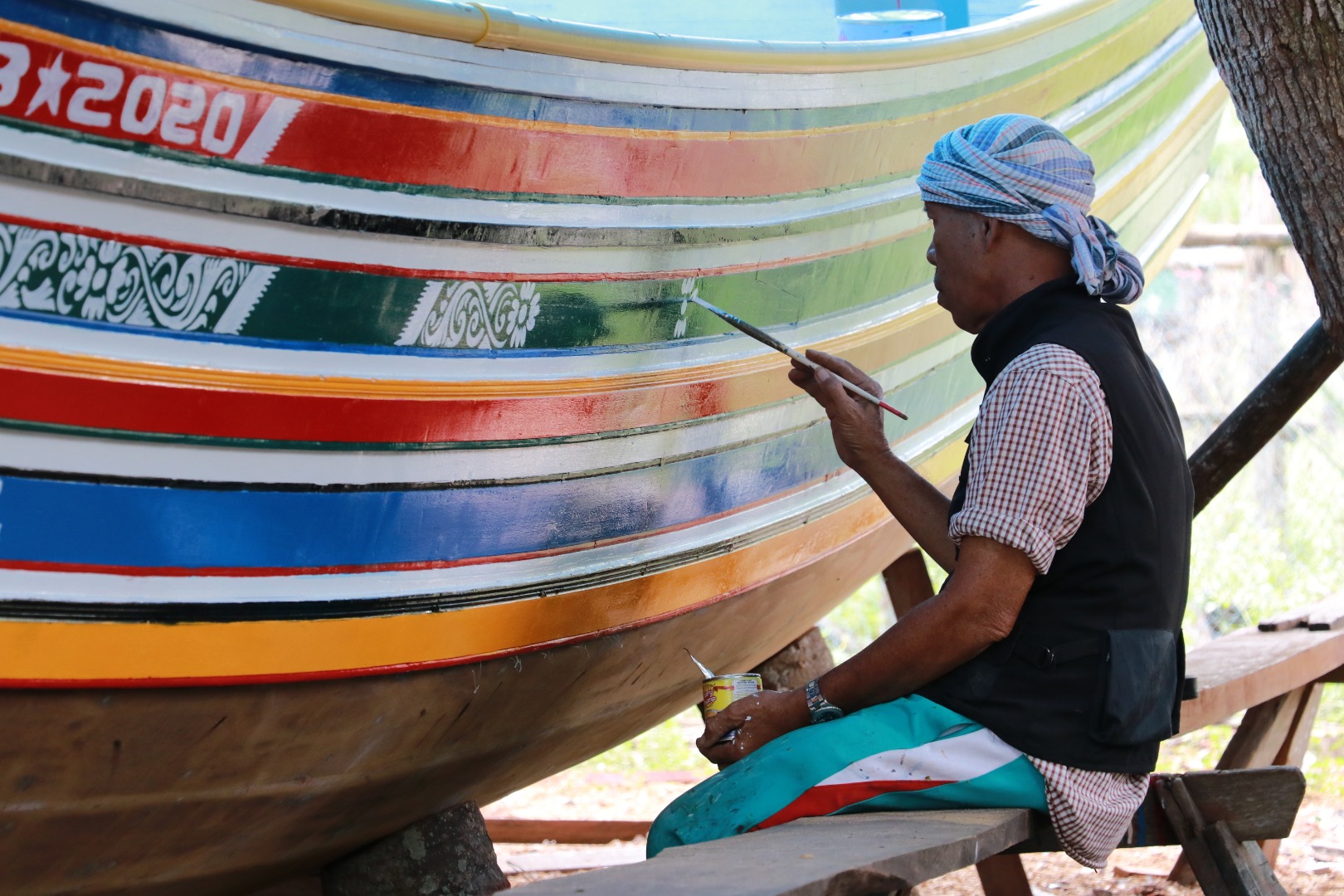Kolae: a Painting on the Ocean

Kolae boats at Talo Kapo beach, Pattani [photo: The Incidental Tourist]
Unique for its design and vibrant decorations, the kolae (กอและ) fishing boat is only found in Thailand’s deep South and typically used by Muslim communities living in the provinces bordering the Gulf of Thailand as far down as Peninsular Malaysia’s Kelantan state.
The word kolae is borrowed from the Malay language, which means to float or wobble. In Thailand, the word is sometimes mispronounced as “kulae” or “pulae”. It refers to a small- to medium-size fishing boat, covered in colorful paintings, with a pointed front and rear. The unique design is thought to have originated from Muslim evangelists during the Sukhothai era (1249-1463) though some believe the design was borrowed from the vessels used by Arabian traders who visited Siam during the Ayutthaya period (1350-1767). Despite the origin debate, the Islamic influence on the kolae has continued to grow in the Southern provinces.
Parts of a Kolae
There are two types of kolae, long bowed and short bowed. Boats are made in four sizes: 12.5 meters, 11 meters, 10 meters, and 3 meters. A special feature of a kolae, called pa-pae-tu-wor, is the embossed sides that look like a bumper. The part below the “bumper”, gouged from head to tail, is called the ko-ma. A boat is divided into two parts: the name of the front half is lu-wae while the rear is known as bu-re-tae.
Originally, the boat had a pointed bow and stern but, the designs has now adapted to accommodate modern modes of fishing. The pointed stern is cut short to allow room for mechanical engine.
Parts of a traditional kolae include:
- The bow is the highest part of the front.
- The ja-ping is the end of the front and back parts of the boat and is considered a sacred part.
- The ba-nga holds a lamp and is also the part to which the anchor is tied.
- The mast is placed at the center.
- Ko-yae or Lo-yae at the rear is used to hold an oar, which can function as a rudder.
- The mu-ka or sa-ngor are placed in the middle and the rear of the boat to hold the rudder and fishing net.
- The stern is the highest part of the rear.
A kolae is usually built out of the wood from a local tree, namely ta-kian (hopea odorata) or lum-por (merbau). Mai-saya (meranti wood) is the more popular choice for a racing kolae.
Building the kolae is done by hand, with the keel the first part to be laid down. U-shaped strips of wood of different sizes, called kong, are then placed from front to rear, with those in the middle the widest and those attached to the bow and stern are the narrowest. Planks are then attached vertically to the kong. Any holes would be covered by a special liquid solution, which is a combination of wood oil and resin. For the interior, planks are placed horizontally from head to tail. The exterior part will then be adorned with vibrant oil paint.
Many parts of the boats are also delicately carved. For example, the triangular ja-ping, the most sacred part of the boat, is sculped in a way that resembles the traditional Thai kanok pattern.
The pattern on the exterior of the boat often starts from the gunwale and is painted in three stripes. The colors can be red, yellow, green, and blue, among others, depending on the artist’s preference. The lower part of the boat is often painted in red. In line with Islamic belief, the patterns cannot depict humans or animals. Instead, a kolae usually boasts colorful flowers or the motifs similar to the Thai traditional kanok (flame-like) pattern.
Some of the kolae boats are decorated in the same way that a royal barge is. For instance, they are both meticulously gilded and lacquered. Despite that, it is not uncommon to see a kolae boat adorned with stained glass as well. However, such scrupulous technique often too expensive and labor-intensive for local artists and so most fishing boats are instead decorated with vibrant paint and patterns–a mixture of Thai, Malay, and Chinese styles.

A work in process [photo: Pattani Heritage City]
Traditions
Traditionally, five or six fishing boats are set out to work together. Each of the fisherman sails from a different direction to meet at the center, where a square dip net is laid. As they maneuver their boats, they force fish into the net.
Though kolae fishermen are mostly Muslims, some animistic traditions are still practiced among them. Before fishing, the men make offerings in a container made from banana leaves or a coconut coir fashioned into a boat shape. This “boat” is floated out as an offering to the God of the Sea. The ritual is only performed by a respected leader or sage. Any boat reaping a big harvest of fish must place a flag at the front of the bow while sailing back to the shore. This is to notify those on land that a garland will be needed to decorate the bow when the boat reaches the shore as a sign of gratitude.
A kolae is treated with the highest respect by fisherfolk, because it is the equipment that feeds their families. Before getting on the boat, a fisherman takes off his shoes. No running is allowed near the front of a beached boat and urination and defecation must not take place near the bow. Vulgar language is also not recommended when on the boat. The ja-ping placed on the bow is considered the guardian of the boat. Before a fishing trip, one must find an auspicious time and perform a dua, an Islamic prayer, to ask for protection and luck from God.
With its unique colors, a kolae stands out as it sails to the fishing grounds, looking for all the world like a vibrant painting floating on the ocean. Little wonder then that the kolae is the pride of the local artists.
**************************
Reference
Lisuwan, Wibun. Rue Kolae [The Kolae Boat]. Watthanatham Journal: Department of Cultural Promotion, vol. 53, no. 1, January-March 2014, p. 26-32. Available at http://magazine.culture.go.th/2014/1/Culturemag2014-1/assets/common/downloads/CultureMag2014-1.pdf.


